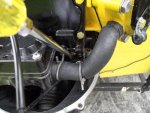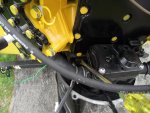yorab
Ensign
- Joined
- Jul 6, 2002
- Messages
- 960
Motor in signature. Trying to get this thing broken in after a complete rebuild. FSM says to run for 1 hr at approximately 3000 rpm. I did that for 40 minutes yesterday but ran into a problem with my ignition coil. I got that fixed and continued the break-in process today. I ran it for 20 more minutes at 3000 rpm. Smooth as can be.
Then, the FSM says to run at 4000 rpm for the 2nd hour and occasionally run full throttle for 1-2 minutes during that 2nd hour. It ran well at 4000 rpm. The first time that I gave it full throttle, things seemed fine. It topped out at 4950 rpm with the 10 X 9 1/4 prop. After a little less than a minute at full throttle, the sound of the motor changed. It didn't sound catastrophic or anything, just different. So I eased back on the throttle. As soon as I eased back, the motor died. The motor felt very hot, like it did a few weeks ago when I tried to run it with the water pipes reversed.
After letting it cool, I started it up again. Seemed to run well, but I noticed that very little, if any water was ejecting from the exhaust relief port. It was a different story yesterday. Here's a video that I took yesterday of the port with the thermostat closed:
http://www.flickr.com/photos/jmm741/5694560603/in/photostream
And here is the water ejecting with the thermostat open:
http://www.flickr.com/photos/jmm741/5694558957/in/photostream
And now, here is the relief port today after the motor shut off:
http://www.flickr.com/photos/29072032@N05/5694568535/in/photostream
I thought that maybe the key had sheared off of the impeller, so after letting it cool again, I restarted and checked for water flow from the starboard cylinder bank to the water choke. Looked good. Here's the video:
http://www.flickr.com/photos/29072032@N05/5694566851/in/photostream
So I'm getting good water flow, but the top of the motor is still getting very hot. I also noticed a water leak near the junction of the thermostat housing, adapter plate, and exhaust cover plate. Here's a video of that:
http://s952.photobucket.com/albums/ae10/yorab/?action=view¤t=Leak.mp4
So, in summary, the motor ran great at 3000 and at 4000 rpm. After about a minute of full throttle, the sound of the motor changed so I eased back on the throttle and it died. It felt very hot on the top of the powerhead. After cooling, the motor started right back up but it seems as though water is not ejecting from the relief port like it did prior to the shut down. However, water is flowing from the top of the cylinder bank to the water choke just fine. There is also water leaking near the bottom of the exhaust cover plate.
Perhaps the vernatherm is not opening properly. This would mean that water is still circulating through the motor (as shown in the video) but cool water is not being introduced since hot water is not being expelled. The vernatherm that I used was NOS, so I assumed it was good. I could try to replace it with my old vernatherm that was only used a few hours before my rebuild.
Any ideas of how I can be sure that enough cooling water is making it to the powerhead? Do the exhaust cover plate bolts usually need to be retorqued after a heating cycle? I don't remember reading that in the FSM. I'll check the torque on those tomorrow.
Then, the FSM says to run at 4000 rpm for the 2nd hour and occasionally run full throttle for 1-2 minutes during that 2nd hour. It ran well at 4000 rpm. The first time that I gave it full throttle, things seemed fine. It topped out at 4950 rpm with the 10 X 9 1/4 prop. After a little less than a minute at full throttle, the sound of the motor changed. It didn't sound catastrophic or anything, just different. So I eased back on the throttle. As soon as I eased back, the motor died. The motor felt very hot, like it did a few weeks ago when I tried to run it with the water pipes reversed.
After letting it cool, I started it up again. Seemed to run well, but I noticed that very little, if any water was ejecting from the exhaust relief port. It was a different story yesterday. Here's a video that I took yesterday of the port with the thermostat closed:
http://www.flickr.com/photos/jmm741/5694560603/in/photostream
And here is the water ejecting with the thermostat open:
http://www.flickr.com/photos/jmm741/5694558957/in/photostream
And now, here is the relief port today after the motor shut off:
http://www.flickr.com/photos/29072032@N05/5694568535/in/photostream
I thought that maybe the key had sheared off of the impeller, so after letting it cool again, I restarted and checked for water flow from the starboard cylinder bank to the water choke. Looked good. Here's the video:
http://www.flickr.com/photos/29072032@N05/5694566851/in/photostream
So I'm getting good water flow, but the top of the motor is still getting very hot. I also noticed a water leak near the junction of the thermostat housing, adapter plate, and exhaust cover plate. Here's a video of that:
http://s952.photobucket.com/albums/ae10/yorab/?action=view¤t=Leak.mp4
So, in summary, the motor ran great at 3000 and at 4000 rpm. After about a minute of full throttle, the sound of the motor changed so I eased back on the throttle and it died. It felt very hot on the top of the powerhead. After cooling, the motor started right back up but it seems as though water is not ejecting from the relief port like it did prior to the shut down. However, water is flowing from the top of the cylinder bank to the water choke just fine. There is also water leaking near the bottom of the exhaust cover plate.
Perhaps the vernatherm is not opening properly. This would mean that water is still circulating through the motor (as shown in the video) but cool water is not being introduced since hot water is not being expelled. The vernatherm that I used was NOS, so I assumed it was good. I could try to replace it with my old vernatherm that was only used a few hours before my rebuild.
Any ideas of how I can be sure that enough cooling water is making it to the powerhead? Do the exhaust cover plate bolts usually need to be retorqued after a heating cycle? I don't remember reading that in the FSM. I'll check the torque on those tomorrow.






















